Thursday, March 28, 2019
Monday, March 25, 2019
Friday, March 22, 2019
Wednesday, March 20, 2019
Tuesday, March 19, 2019
Monday, March 18, 2019
Spotted Lanternfly Quarantine in Dauphin County
For those of you unfamiliar with the Spotted Lanternfly, you can read more about it here. The Spotted Lanternfly quarantine now includes Dauphin County.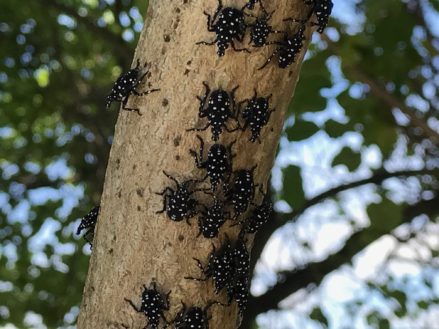
According to the Pennsylvania Department of Agriculture (PDA), Dauphin County is now part of the Spotted Lanternfly quarantine zone. Let’s take a quick look at what this means for businesses and homeowners in Dauphin County.
Impact on Businesses
If you operate a business in Dauphin County that has commercial vehicles (company cars, service trucks, etc.), the quarantine applies to you.
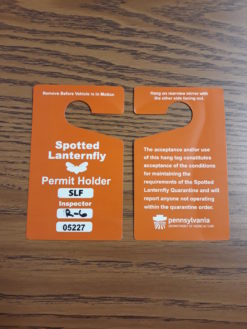 Businesses that operate company vehicles inside the quarantine zone are required to register with the Department of Agriculture for quarantine compliance. Basically, this involves someone from the business or organization passing a test on how to inspect for Spotted Lanternfly adults, nymphs, and eggs.
Businesses that operate company vehicles inside the quarantine zone are required to register with the Department of Agriculture for quarantine compliance. Basically, this involves someone from the business or organization passing a test on how to inspect for Spotted Lanternfly adults, nymphs, and eggs.
Once that training is complete, the individual in the organization that passed the exam is required to organize a training for the rest of the business to ensure compliance. Once completed, you receive orange placards that you must display from your rearview mirror. These placards indicate that you’ve inspected your vehicle to ensure you’re not transporting any Spotted Lanternfly adults, nymphs, or eggs.
It sounds pretty onerous and time-consuming, but it’s really not that much of a burden. Once you know what to look for and how to do a quick inspection, it goes pretty quickly.
Final note: this applies to ALL businesses operating commercial vehicles inside quarantine zones. This isn’t just something landscapers and lawn care companies are responsible for. Plumbers, carpenters, roofers, you name it – if you’re operating a vehicle with a business name on it, you’re responsible for understanding the quarantine, and displaying a placard.
You can find more information about permit requirements here.
Homeowner Responsibility
Homeowners have some responsibility in this, too.
Spotted Lanternfly nymphs aren’t the brightest. They’ll congregate in huge numbers in seemingly random places. I’ve seen a picture of thousands of stage 4 nymphs (the black and red ones, right before they reach adulthood) on the tires of a wheeled bulldozer.
This makes a homeowner’s role in slowing the spread of this pest even more important. The PDA has compiled a checklist of things that homeowners should inspect prior to travelling. You can find the full list here, but they include:
- Campers, RV’s, and Motor Homes

- Tents and tarps
- Firewood and lumber stored outside
- Propane or oil tanks
- Barbecue grills
- Outdoor furniture
- Bricks, pavers, and cinder blocks
- Dog houses, chicken coops, and storage sheds
- Yard decorations and garden tools, including lawn mowers
- Yard debris
- Trees, shrubs, and other plants, especially if purchased in part of the Quarantine Zone
- Kiddie pools and play houses
- Bicycles, scooters, etc.
- Old pallets
As you can see, there’s a lot of stuff to check out. The adult stage, when they’re mating later in the season, will lay their eggs on any and all of these items.
Also, if you live outside the quarantine zone, please continue to report sightings of the Spotted Lanternfly. This helps Penn State and the Department of Agriculture keep track of how quickly it is spreading, and expand the quarantine zone if needed. You can use this site to report a sighting. Click here to see if your county is currently under the quarantine.
Why is this important for me?
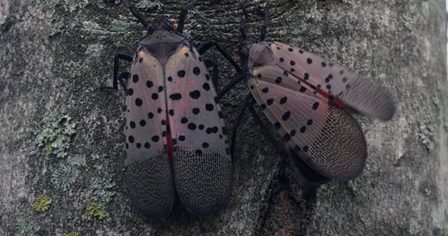 There’s lots of reasons this impacts us here Lancaster, Dauphin, York, and Lebanon Counties. The economic impact of this pest alone is potentially catastrophic.
There’s lots of reasons this impacts us here Lancaster, Dauphin, York, and Lebanon Counties. The economic impact of this pest alone is potentially catastrophic.
Spotted lanternfly is currently feeding on plants with a high sugar content in the sap. According to researchers at Penn State, Pennsylvania is the number one exporter of hardwoods (like maple) in the United States. We’re number four in the nation in apple and peach production, and fifth in the country in grape production. We haven’t even mentioned the landscape and nursery industry. These are all targets for the Spotted Lanternfly to feed on.
The current value of these commodities that will potentially be impacted is staggering. The value of the three fruit crops mentioned above is about 134 million dollars of the current Pennsylvania economy. The landscape and nursery stock would mean potential damage to over 940 million dollars in commerce here in the Commonwealth. The damage to hardwood production is potentially devastating – Pennsylvania currently earns almost 17 billion dollars from hardwoods each year.
The potential disruption of nearly 17.8 billion dollars in revenue in the State’s economy impacts us all.
In addition, there’s the potential for this pest to disrupt property values, tourism, and our native ecosystem. It doesn’t have a natural predator here in North America (being native to Asia), so there’s no real way to calculate the havoc it might wreak with our native plant and insect balance.
Keep checking in with us regularly for updates on the Spotted Lanternfly as they become available. If you have concerns about the potential damage to your landscape, feel free to Contact Us for a free consultation. We’re happy to talk to you about a tailored management plan for your property.
The post Spotted Lanternfly Quarantine in Dauphin County appeared first on Tomlinson Bomberger.
from Tomlinson Bomberger https://ift.tt/2FjBiqr
Wednesday, March 13, 2019
Shopping on Price Alone for Tree Pruning is Pointless
This short blog focuses only on the importance of proper tree pruning related to price shopping. If you are interested in ‘topping’, ‘cutting back’, ‘shaping’ or having your tree removed for the ‘lowest price’ you can find, you should click to the next website now. Shopping alone for tree pruning is pointless.
If your interest lies in healthy, strong, productive, aesthetically-pleasing trees with generational longevity, read on.
Considerations
Many extenuating circumstances can affect the pricing for pruning or removing trees on an owner’s property. It is unfair to both the consumer and the contractor not to meet. You should discuss in detail the pruning project in question.
Trees are and should be considered ‘legacy plants’ in your landscape. It is common for well-maintained deciduous trees to live for over 100 years in an urban landscape. Certain evergreen trees may even live longer. The trees we plant and love today will be around for our great-grandchildren to enjoy, if we maintain them properly during our lifetimes.
Environmental factors, diseases, and insects can all affect a tree’s overall health. We can mitigate these influences only by proper plant selection, installation procedures and pruning practices.
When to call a Professional
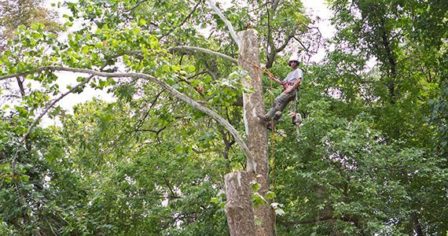 Weekend gardeners, enthusiasts and DIYer’s are encouraged to call on the professional when the pruning heights reach beyond a pole pruners capability. Tree pruning is intrinsically dangerous. A 2009 study done by the US Census for Fatal Occupational Injuries concluded that tree limbs falling in unexpected directions was the primary cause of injury in tree related accidents. Improper equipment coupled with dual and unsafe chainsaw usage are huge risks. These are compounded by a lack of general horticultural knowledge, which is a recipe for unhealthy trees. Also, let’s not minimize placing yourself at personal risk!
Weekend gardeners, enthusiasts and DIYer’s are encouraged to call on the professional when the pruning heights reach beyond a pole pruners capability. Tree pruning is intrinsically dangerous. A 2009 study done by the US Census for Fatal Occupational Injuries concluded that tree limbs falling in unexpected directions was the primary cause of injury in tree related accidents. Improper equipment coupled with dual and unsafe chainsaw usage are huge risks. These are compounded by a lack of general horticultural knowledge, which is a recipe for unhealthy trees. Also, let’s not minimize placing yourself at personal risk!
So, you’ve reached the point that your trees have outgrown your ‘green thumb’s’ reach, what’s next? First, you deserve credit for recognizing that fact. Also, caring enough about yourself and your trees to look toward professional assistance is laudable!
Who to call?
Arboriculture is “the cultivation, management and study of individual trees, shrubs, vines and other perennial woody plants. The science of Arboriculture studies how these plants grow and respond to cultural practices and to their environment.”
Reaching out to several Tree Care contractors to set-up and an onsite consultation is a great start. Companies affiliated with the International Society of Arboriculture (ISA) or the Tree Care Industry Association (TCIA) are a prudent first call. These companies are deeply invested in their staff’s education and training, as well as, the culture and science of arboriculture.
Often you are likely to be introduced to a Certified Arborist who represents the company. They will discuss your concerns and expectations regarding your proposed tree work. This individual often has years of experience in the field. They are also required to complete Continuing Education Units (CEU’s) annually to maintain their Arborist certification.
The Arborist or Account Manager should diligently listen to your concerns and expectations before conducting their own evaluation of the tree in question. The evaluation will focus on overall plant health, safety and risk factors, and necessary pruning requirements. Assuming the tree(s) pose no eminent danger to the public or any property, pruning and/or plant health care (PHC) recommendations will be made for the tree.
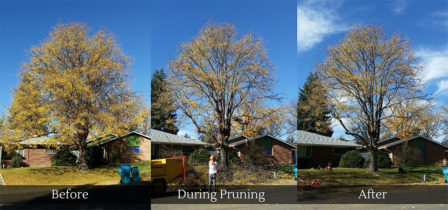 The service
The service
Pruning is as much art as it is science. One of the nicest compliments an Arborist can receive after completing a pruning job is, “It doesn’t look like you did anything to the plant!”. A properly pruned plant should maintain the structure of its natural state while accomplishing the required outcome of the recommendations.
Arborists and tree care technicians use terms like – crown clean, crown thin, crown raise & reduce to direct pruning processes. Percentages and specific feet/inch instructions are given for each process to be performed on the given tree. A sample pruning spec for a tree may read something like this –
“Scarlet Oak (30” dbh), along right rear property line. Crown clean all dead wood > 1” dia., crown raise to 12-15’ above ground grade, crown thin 8-10%, clean-up & haul away all generated debris.”.
These instructions tell the pruning crew to look for the large Scarlet Oak tree in the back yard along the property line. They’ve been instructed to remove dead wood in the tree one-inch or greater. They will remove limbs of the tree that are within 12-15 feet of ground level. They’re also going to remove about eight-to-ten percent of the canopy to allow air flow. Finally, they’ll clean up the whole site.
While in the tree, Arborists will look for any dead, dying & diseased branches, any crossing or rubbing branches, and any weak or structurally poor branch attachments and remove or properly prune the structures.
Selecting a contractor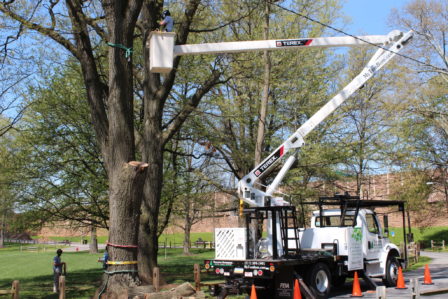
As an educated consumer of any skilled service trade or professional practice, it is apparent that price shopping and comparing “apples to apples” is a prudent fiscal responsibility before making a buying decision. Our “apples to apples” comparison begins with the consumer realizing they are not asking for their plants to become “geometric shapes.” Rather, a plant managed by a professionally-trained Arborist will ideally remain healthy and fruitful for decades.
As you select your service contractor, make sure they are properly licensed and insured. This is particularly important in the tree care industry. Review testimonials, references or even ask to see examples of completed projects. One factor that will affect pricing is the size and quantity of trees to be pruned. Another is the accessibility of the trees in relationship to the equipment needed for the project. Also, the duration of time between the last time the trees were pruned and even the distance the contractor must travel to complete the project are considerations.
If a tree is within the proximity of power lines, contacting the utility company is mandatory before beginning the project. Utility companies may complete some of the work at no charge to the customer if safety or potential power interruption is a threat due to the tree’s health or location.
Conclusion
We have touched on many of the extenuating circumstances that may affect tree pruning pricing. More importantly attempted to point out the significance of proper decision-making when the time rolls around to have your “legacy plants” managed with stewardship and thoughtfulness for our next generations to enjoy!
Please Contact Us today for a professional tree and plant health care consultation.
The post Shopping on Price Alone for Tree Pruning is Pointless appeared first on Tomlinson Bomberger.
from Tomlinson Bomberger https://ift.tt/2NYS2FU
Tuesday, March 12, 2019
Monday, March 11, 2019
Friday, March 8, 2019
I Keep 2 House Plants Alive and Kill the Rest

We’re hearing and reading everywhere that house plants are having their day, and I’m all in – as long as they’re growing in someone ELSE’s house. I have a strict tough-love policy for indoor plants, which only two species have been tough enough to survive long-term.
I can’t really explain my aversion to fussing with indoor plants. After all, outdoors I grow potted annuals that I happily water every day it doesn’t rain. But the idea of wiping some tropical plant’s leaves every day to prevent some infestation or other is ludicrous to me!

So I’ll stick with the two apparently fool-proof house plants I’ve kept alive for 20-30 years now (I’ve lost track) by watering every two weeks, and that’s it. No wiping of leaves, no feeding, no repotting.
One is a Hoya of some type or other. It’s hanging in my living room right now (top photo) but will spend the summer under a skylight in my porch, where it still only needs bi-weekly watering and even blooms! And the bloom is super-fragrant.

My other unkillable house plant is the lowly Philodendron, which I’d consider trading for an artificial one if I could find one that didn’t look cheesy. My two are surviving in the inauspicious location above – at ceiling level – and in my previous homes it’s been in spots with even less light.

Yet look how healthy they are!

Lately, my house plant situation was complicated by this gorgeous succulent-filled pot I was given at Christmas (by someone who doesn’t use the Internet and won’t see this post). My cat Harry was happy to pose with it after rejecting it as something to eat.

Two and a half months later, it’s almost time for hospice care. With nowhere sunny enough to put the damn thing and just one small off-center drain hole, I knew the plants were doomed and even considered regifting the pot to a better, sunnier home.
I chose instead to reframe my thinking. I see these plants now as lovely but fleeting, like cut flowers. My guilt over killing them is gone.
I Keep 2 House Plants Alive and Kill the Rest originally appeared on GardenRant on March 8, 2019.
from GardenRant https://ift.tt/2C5QwwT
Monday, March 4, 2019
Friday, March 1, 2019
The Latest from Doug Tallamy

GardenRant posts this week have gone there – questioning the rarely questioned conventional wisdom these days about native-plant superiority and criticism of those who plant so-called “exotics.” Today I’m adding to the discussion the latest from the most famous native-plant advocate of them all – Dr. Doug Tallamy of the University of Delaware’s Department of Entomology and Wildlife Ecology. He spoke this week at a “Green Matters” symposium near me.

I’d heard Tallamy speaker before and once again, he was amazing, even fighting a cold. He makes his case in an approachable, inviting way that doesn’t blame gardeners! He does blame people who use their acreage to grow nothing but useless turf – blame that I support wholeheartedly.

Central to our recent discussion, Tallamy went on to describe the traditional criteria we homeowners have used in choosing plants for our gardens and yards – aesthetics, including finding the right focal point and anchors for garden design, and maybe some plants that create privacy.
Did he tell the audience we’re BAD, unethical, selfish people for caring about “decorative value,” as some native-plant purists do? Au contraire! He simply urged us to ADD ecological criteria like restoring soil, protecting watersheds and of course, supporting food webs when choosing garden plants. (Notice: not JUST feeding his beloved insects but the whole range of eco-services that plants – from anywhere – typically provide.)

This slide is an aerial view of Tallamy’s own home landscape, which he happily noted even includes a bit of lawn. Unlike so many of his most vocal supporters, he’s no purist.
I count myself among Tallamy’s many fans for his inclusive and – let’s be honest – realistic message, which I believe results in many more native plants being bought and kept alive than the natives-only approach ever could.
It also helps the medicine go down that Tallamy seems like a genuinely nice person, not intent on shaming us gardeners.

Moving on, I found the image above of the inside of a pithy perennial stem very convincing, making the case for leaving stems up through the winter. On the right are some pithy-stemmed perennials in the winter garden.

Finally, I have a question I’d love to have had the chance to ask Tallamy – about ground-nesting bees, which he encourages people to leave some bare ground for, or at least ground that’s easily dug up.
I used to have a garden large enough to set aside space for ground nests, somewhere I’d never have to tend up close. But now in my small, highly-tended garden there’s no way I want to encourage ground nests. Though Tallamy told us not to worry, saying the ground-nesters won’t sting, like yellow jackets do, I’ve been attacked by swarms of ground-nesters myself, by bumblebees and some others I couldn’t identify. Not only is it scary and painful for the gardener; it can result in the ground nests being destroyed by the (sad, guilty-feeling) gardener. So what’s the answer?
Big picture, let’s keep reading Tallamy but also look at the results from other researchers in fields outside entomology and ecology that point to conclusions contrary to his. I say the more research the better, especially when results are assessed with an open mind.
The Latest from Doug Tallamy originally appeared on GardenRant on March 1, 2019.
from GardenRant https://ift.tt/2TaS1o6
First Lady Jill Biden and the White House Garden
Now that almost everyone concedes that the Bidens will be moving into the White House soon (hopefully, soon enough!), local garden writers ...

-
Now that almost everyone concedes that the Bidens will be moving into the White House soon (hopefully, soon enough!), local garden writers ...
-
One of the most common calls we get throughout the season is about “patchy” looking lawns. These calls can come from current clients or pot...
-
Gardeners have a complicated relationship with their gardens. The balance of power goes back and forth, much like any other serious relation...